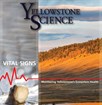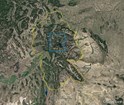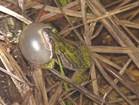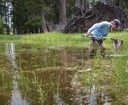The early proponents of wildland conservation exercised extraordinary vision when they proposed the establishment of America’s first national park. In this era of rapid environmental change, declining trends in population sizes, and increased species extinction rates, we must also be forward-looking in our anticipation of future change and formalize a monitoring program that carefully tracks and regularly assesses the most vital indicators of ecosystem health.
-
Yellowstone National Park
Article 1: Yellowstone Science 27(1) - Vital Signs

Download a PDF of the entire issue. Read more
-
Article 2: Vital Sign Monitoring is Good Medicine for Parks
Nearly 70 years ago, a young ranger naturalist working in Yellowstone National Park (YNP), Frederick B. Turner, became fascinated with the abundance of frogs next to his cabin at “Soldier Creek” (known as Lodge Creek today). This interest blossomed into Turner’s PhD research and his publication in 1960 about the local population of Columbia spotted frogs became a classic for herpetologists... Read more
-
Yellowstone National Park
Article 3: Understanding Dynamic Ecosystems: The Pursuit of the Greater Yellowstone Network

The year 1999 was a pivotal year for the National Park Service (NPS). Inspired by the book Preserving Nature in the National Parks: A History (Sellars 1997), the Natural Resource Challenge (NPS 1999) was crafted to expand the NPS’s understanding and management of park natural resources. One of the more innovative outcomes of the Natural Resource Challenge was the creation of the NPS Inventory and Monitoring (I&M) Program... Read more
-
Yellowstone National Park
Article 4: Assessing the Ecological Health of the Greater Yellowstone Ecosystem

Species declines and extinctions are occurring at rates that are unrivaled in human and geological history (Ceballos et al. 2017). Similarly, wild places are also dwindling in area (Watson et al. 2018). Some large, protected areas like the Greater Yellowstone Ecosystem (GYE) have experienced less change than more populated corners of the world primarily because the GYE benefits from a substantial level of federal agency protection... acre-ecosystem wit Read more
-
Yellowstone National Park
Article 5: The Spatial Footprint and Frequency of Historic Snow Droughts in Yellowstone

In the face of climate change and increasing human pressures, monitoring and characterizing environmental change is increasingly important in national parks and protected areas (Hansen and Phillips 2018). Regional measurements of snowpack are a critical vital sign (see “Vital Signs Monitoring is Good Medicine for Parks,” this issue) both for monitoring ecosystem health and anticipating future water availability... Read more
-
Yellowstone National Park
Article 6: Nowcasting & Forecasting Fire Severity in Yellowstone

Climb any mountain in the spring, and you will find that Yellowstone National Park (YNP) is made almost entirely in shades of green. Many grayish-blue peaks encircle the far horizon; but in the park itself, only a few nunatak mountains push up pinpoints of bare rock. Thick, green forests cover 80% of the landscape. Grassy valleys and sagebrush fill in most of the rest (Despain 1990). Yellowstone is defined by its plants... Read more
-
Yellowstone National Park
Article 7: Patterns of Primary Production & Ecological Drought in Yellowstone

Photosynthesis converts sunlight into stored energy in millions of leaves, flowers, and seeds that maintain the web of life in Yellowstone. This transformation of energy fixes carbon, supplies organic matter to soils, and creates fuel for wildfire. As the first link of the food chain, new plant biomass is called primary production and provides energy to consumers, including wildlife... Read more
-
Yellowstone National Park
Article 8: Surrogate Species: Piecing Together the Whole Picture

National parks, such as Yellowstone National Park (YNP), are ecologically and socially important resources conservatively valued at $92 billion (Haefele et al. 2016). To properly protect and conserve these places, decision makers require reliable information to track and understand the manifestations of environmental change... Read more
-
Yellowstone National Park
Article 9: Tribute: Tom Henderson

Tom Henderson, a friend and colleague of Yellowstone National Park, passed away unexpectedly in October 2018. Tom was a devoted husband and father and a Senior Environmental Project Manager with the Montana Department of Environmental Quality’s (DEQ) Abandoned Mine Lands Program. Many in Yellowstone worked with and knew Tom for his leadership role in the reclamation and clean-up of the abandoned McLaren Mill and Tailings site on Soda Butte Creek... Read more
-
Yellowstone National Park
Article 10: SHORT: Yellowstone Birds Are Vital

Traveling through Yellowstone National Park (YNP), visitors frequently stop to enjoy the park’s birds: small songbirds flitting about the willows, sandhill cranes engaged in their ritual mating dances, or myriad species of waterfowl loafing in one of the park's many wetlands. Typically while driving the roads of YNP, a majority of visitors consider a stopped car and raised binoculars a sure sign of some large mammal sighting... Read more
-
Yellowstone National Park
Article 11: SHORT: Yellowstone bats important indicator ecosystem health

The popularity of Yellowstone National Park (YNP) is often gauged by the abundance of wildlife that calls it home, but the ecological health of the park is regularly assessed by a suite of indicator species. Bioindicators are typically species or species groups that are easily observed; however, a silent gray blur darting overhead at twilight may turn out to be an important indicator of environmental health... Read more
-
Yellowstone National Park
Article 12: SHORT: Taking the Pulse of Wetlands

Why indeed care about tiny frogs, with so many spectacular and elsewhere-rare animals inhabiting Yellowstone National Park (YNP)?... Read more
-
Yellowstone National Park
Article 13: SHORT: The Yellowstone River Fish-Kill

Trout are socioeconomically and ecologically important in the Greater Yellowstone Area (GYA), yet these fish face numerous threats. Disease may begin to play a larger role in reducing fish populations, partly because many existing threats may interact to exacerbate the frequency, extent, and severity of fish diseases (Lafferty 2009)... Read more
-
Yellowstone National Park
Article 14: SHORT: Insects as a Vital Sign in the GYE

Insects far outnumber vertebrates in Yellowstone National Park (YNP), North America, and worldwide. In fact, 80% of all named species are invertebrates (Cardoso et al. 2011). Despite their abundance, ecological importance, and benefits to society, numerous opportunities for discovery and for elevating the understanding of insects’ contributions to health of ecosystems still remains... Read more
-
Yellowstone National Park
Article 15: SHORT: Aquatic Vascular Macrophytes as Vital Signs

Large, readily visible plants (macrophytes) are central species of aquatic ecosystems. Macrophytes have diverse morphological and ecological strategies for living in divergent ecological conditions or niches that span the water column. For example, macrophytes can be free-floating on the surface, entirely or partially submerged, and emergent. Of the 41 vital signs selected for Yellowstone National Park (YNP), nearly two of every five (40%) can be connected to macrophytes... Read more
-
Yellowstone National Park
Article 16: SHORT: Invasive Plants as Indicators of Ecosystem Health

Healthy, native plant communities provide sustainable habitat for wildlife, insects, and soil biota. They can persist through drought and contribute to ecosystem services, such as clean air and water. When invasive species are introduced into a native plant community, there can be numerous deleterious efects with minor to major consequences... Read more
-
Yellowstone National Park
Article 17: SHORT: An Uncertain Future: the Persistence of Whitebark Pine in the Greater Yellowstone Ecosystem
If ever I was to love a tree, this is the tree (figure 1) that would own my heart. Enduring gracefully at the base of a narrow, high-elevation cirque in the Wind River Range, it is a challenging off-trail scramble to be in its presence. My first encounter with this massive whitebark pine was in July 2014. Located just a stone’s throw from our monitoring plot, I felt compelled to pay homage to this incredible specimen that has clearly withstood hardship... Read more
-
Yellowstone National Park
Article 18: SHORT: Past Warm Periods Provide Vital Benchmarks for Understanding the Future of the Greater Yellowstone Ecosystem

The wildlife, vegetation, and ecosystems discussed in this issue of Yellowstone Science are vital signs of the Greater Yellowstone Ecosystem (GYE) that warrant continued monitoring. Determining which organisms and processes are truly vital ecosystem components requires both an understanding of modern ecological interactions and insight into the resilience of organisms and processes to stressors in the past... Read more
-
Yellowstone National Park
Article 19: SHORT: What We’re Listening To: How Sound Inventories Can Contribute to Understanding Change

Do you want to get off the beaten track and experience Yellowstone in an entirely new way? If you answered “yes,” visit Black Sand Pool and turn an ear to the ground. The giant, imploding bubbles in Black Sand Pool make a low-frequency sound that you’ll feel through your whole body. It’s undeniably an Earth sound—a planetary sound. And listening to a hot spring is an entirely different experience than looking at a hot spring... Read more
-
Yellowstone National Park
Article 20: SHORT: Improving Visitor Preparedness and Safety in the Bear Country of Yellowstone National Park
On August 23, 2018, a grizzly mother attacked a 10-year-old boy who was hiking the Divide Trail southeast of Old Faithful. While he was badly injured, his parents prevented the attack from being much worse due to the quick actions and use of bear spray. The bear spray had been rented from a new innovation in the park called Bear Aware, L.L.C., where visitors may rent bear spray and also receive training in the use of bear spray and on bear activity in the park... Read more
-
Yellowstone National Park
Article 21: SHORT: How Have Yellowstone Backpackers Changed?
Yellowstone National Park, comprises 3,472 square miles, is known for its beauty, diversity of flora and fauna, and recreation opportunities (YNP 2016). However, most visitors never go beyond a few steps from the roads and boardwalks in the park. Many visitors appear to be in a hurry and want to see the Yellowstone highlights. Indeed, Yellowstone provides a cornucopia of sights, sounds, and smells... Read more
-
Yellowstone National Park
Article 22: A Day in the Field: Citizen Science Engagement
Understanding long-term environmental change and documenting patterns in nature requires rigorous protocols, dedicated observers, and a long-term commitment. Increasingly citizen scientists or volunteers from outside the scientifc community are contributing to monitoring programs that are difcult or impossible to carry out (Bonney et al. 2009)... Read more
-
Yellowstone National Park
Article 23: News & Notes

Yellowstone National Park (YNP) supports one of the most significant aquatic ecosystems in the U.S. Headwater streams and rivers emerge from the park and join to become three of America’s most important waterways and ultimately flow into the Pacific and Atlantic oceans: the Yellowstone River, the Missouri River and the Snake River. At the heart of YNP lies Yellowstone Lake—the largest alpine body of water in North America... Read more
-
Yellowstone National Park
Article 24: Sneak Peek

The grassland and sagebrush-steppe habitats in and near Yellowstone National Park (YNP) have been referred to as America’s Serengeti because they support abundant and diverse ungulates and their predators. Thousands of bison and elk, and hundreds of bighorn sheep, deer, and pronghorn migrate seasonally across the landscape where they interact with black bears, coyotes, grizzly bears, and wolves, thereby providing one of the premier places in the world... Read more


